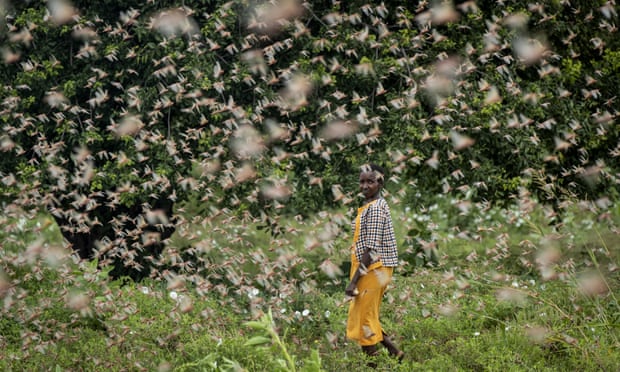The worst outbreak of desert locusts in Kenya in 70 years has seen hundreds of millions of the insects swarm into the east African nation from Somalia and Ethiopia. Those two countries have not had an infestation like this in a quarter century, destroying farmland and threatening an already vulnerable region with devastating hunger.
“Even cows are wondering what is happening,” said Ndunda Makanga, who spent hours Friday trying to chase the locusts from his farm. “Corn, sorghum, cowpeas, they have eaten everything.”
When rains arrive in March and bring new vegetation across much of the region, the numbers of the fast-breeding locusts could grow 500 times before drier weather in June curbs their spread, the United Nations said.
“We must act immediately,” said David Phiri of the UN’s Food and Agricultural Organisation (FAO), as donors huddled in Kenya’s capital, Nairobi, a three-hour drive away.
About $70m is needed to step up aerial pesticide spraying, the only effective way to combat them, the UN said. That won’t be easy, especially in Somalia, where parts of the country are in the grip of the al-Qaida-linked al-Shabab extremist group.
Even a small swarm of the insects can consume enough food for 35,000 people in a single day, said Jens Laerke of the UN humanitarian office in Geneva.
Farmers are afraid to let their cattle out for grazing, and their crops of millet, sorghum and maize are vulnerable, but there is little they can do.
About 70,000 hectares of land in Kenya are already infested.
“This one, ai! This is huge,” said Kipkoech Tale, a migratory pest control specialist with the Ministry of Agriculture. “I’m talking about over 20 swarms that we have sprayed. We still have more. And more are coming.”
A single swarm can contain up to 150 million locusts per sq km of farmland, an area the size of almost 250 football fields, regional authorities said.
One especially large swarm in northeastern Kenya measured 60km long by 40km wide.
Kenya needs more spraying equipment to supplement the four planes now flying, Tale said. Ethiopia also has four.
They also need a steady supply of pesticides, said Francis Kitoo, deputy director of agriculture in south-eastern Kenya’s Kitui county.
“The locals are really scared because they can consume everything,” Kitoo said. “I’ve never seen such a big number.”
The locusts eat the fodder for animals, a crucial source of livelihood for families who now worry how they will pay for expenses like school fees, he said.
“They will lay eggs and start another generation,” he said.
A changing climate has contributed to “exceptional” breeding conditions, said Nairobi-based climate scientist Abubakr Salih Babiker.
Migrating with the wind, the locusts can cover up to 150km in a single day. They are now heading toward Uganda and fragile South Sudan, where almost half the country faces hunger as it emerges from civil war. Uganda has not had such an outbreak since the 1960s and is already on alert.
The locusts also are moving steadily toward Ethiopia’s Rift Valley, the breadbasket for Africa’s second-most populous country, the U.N. said.
“The situation is very bad but farmers are fighting it in the traditional way,” said Buni Orissa, a resident of Ethiopia’s Sidama region. “The locusts love cabbage and beans. This may threaten the shaky food security in the region.”
Even before this outbreak, nearly 20 million people faced high levels of food insecurity across the East African region long challenged by periodic droughts and floods.
As exasperated farmers look for more help in fighting one of history’s most persistent pests, the FAO’s Locust Watch offers little consolation.
“Although giant nets, flamethrowers, lasers and huge vacuums have been proposed in the past, these are not in use for locust control,” the agency said. “People and birds often eat locusts but usually not enough to significantly reduce population levels over large areas.”








































admin in: How the Muslim Brotherhood betrayed Saudi Arabia?
Great article with insight ...
https://www.viagrapascherfr.com/achat-sildenafil-pfizer-tarif/ in: Cross-region cooperation between anti-terrorism agencies needed
Hello there, just became aware of your blog through Google, and found ...